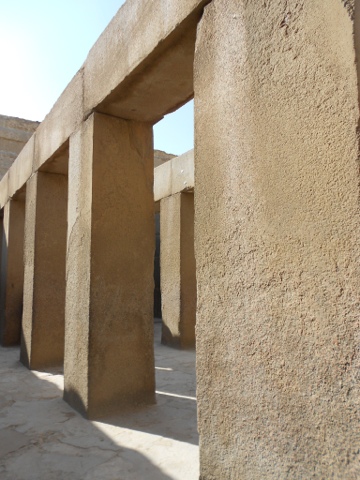We were to visit the Giza plateau and the pyramids first thing this morning, and then move on to downtown Cairo in the afternoon to see the Egyptian Museum. After we all board the bus, Medhat announces a change of plans: It is very hazy and the visibility is poor, which would be detrimental to viewing the pyramids properly, so we'll go to the museum now and come back to Giza in the afternoon when the air is clearer. Besides, we'll avoid the worst of the weekend traffic that way -- Thursday is the Muslim world's 'Friday' and weekend getaway time. Good choice.
We arrive at Tahrir Square where we see some remains of the tents and installations of the "Occupy Tahrir" movement. Otherwise it seems to be business as usual, which means unspeakable traffic chaos, constructions sites and the burned out hulks of government buildings, ransacked during the revolution. We arrive at the Museum a bit before it opens, which gives us plenty of time to get the tickets and visit the outdoor displays, especially the restored sarcophagus of Akhenaten. Not much of the original, smashed pieces have survived, but there was enough to reconstitute the way it looked. Quite moving to see and touch such an important monument. We had left our cameras in the bus (no photo allowed inside the museum), but I still had my iPad with me...
Once inside the museum, Medhat and Dr. Kemp give us a quick overall tour, mostly highlighting the Amarna period pieces, but also commenting on the more important artifacts from all eras of ancient Egypt. It's like I'm meeting old friends, even though it is my first ever visit here. I have spent so many hours studying these very pieces in my books throughout my life, I feel I know them intimately. We have a limited amount of time, so I keep reminding myself that it's OK, I'll come back here again in two weeks, otherwise I'd still be there curled up in a ball somewhere, with everybody looking for me...
The Museum is old and dusty, the artifacts poorly lit and displayed. Old faded description cards, some typed by Carter himself in the 1930's, still accompany the artifacts from Tutankhamun's tomb. I can't wait for the new museum to be built in Giza. These treasures really need to be better displayed and curated.
Speaking of Giza, that's our next stop. I cannot say that I feel the same depth of emotional response to the Pyramids and Sphinx as I do to smaller, more intimate monuments and artifacts where I feel the hand of the sculptor, the vision of the artist. Yes they are big, yes they are marvels of ancient engineering, and yes they are at the center of an abominable circus of hawkers, vendors, camel riders and other riffraff. Within seconds of stepping off the bus I am accosted by a vendor who takes the pith helmet off my head and replaces it with a Bedouin headdress, while pushing Chinese-made designer resin pyramids into my hands and shoving cheap postcards under my nose... Denny rescues me just in time, grabs me by the arm and whisks me away! Already I want to get back to the hotel right and forget the whole visit. These people are rude and their tactics are counter-productive. It totally kills any interest I have. I'll probably never want to visit Giza again.
We take refuge in the Boat Museum, home of the 4,500 year old cedar barque of King Khufu, builder of the Great Pyramid. It was found right at the foot of the Pyramid, in the 1950's if I'm correct, and painstakingly reassembled. We are asked to cover our shoes with funny looking cotton booties to prevent tracking contaminating dirt inside. I can't believe the size of the timber used in the making of this craft. The cedar came from Lebanon. Those forests are long gone now. The only trees that could supply such lumber today would be the great sequoias of the American West Coast.
Dr. Barry and some of the other tour members show up after a while, and I climb all those stairs again, viewing the boat and engaging in more scholarly discourse.
Medhat has prepared yet another surprise for us. We are to visit two recently re-excavated mastaba tombs that will probably never be fully open to the public. He is really like a magician pulling rabbits and doves out of his hat, except his rabbits happen to be exquisitely carved and painted tombs of the 4th and 5th dynasties. These two visits save the day as far as I am concerned.
Then on the to Sphinx and the Valley Temple of Khafre next to it. The vendors are thick as flies on a rotting fruit. Very aggressive. One calls me "Rambo", another "Osama", while Denny gets the monicker of "Mr. Cowboy", no doubt due to his hat. The Valley Temple is enigmatic with its Cyclopean architecture of immense red granite blocks. Very stark and impressive. Walk back to the bus and short ride to the hotel. We say our goodbyes to Nassir our driver, as tomorrow we will be traveling aboard 4-wheel drive vehicles to Saqqara on what will be the last day of the Pharaohs of the Sun tour.









No comments:
Post a Comment